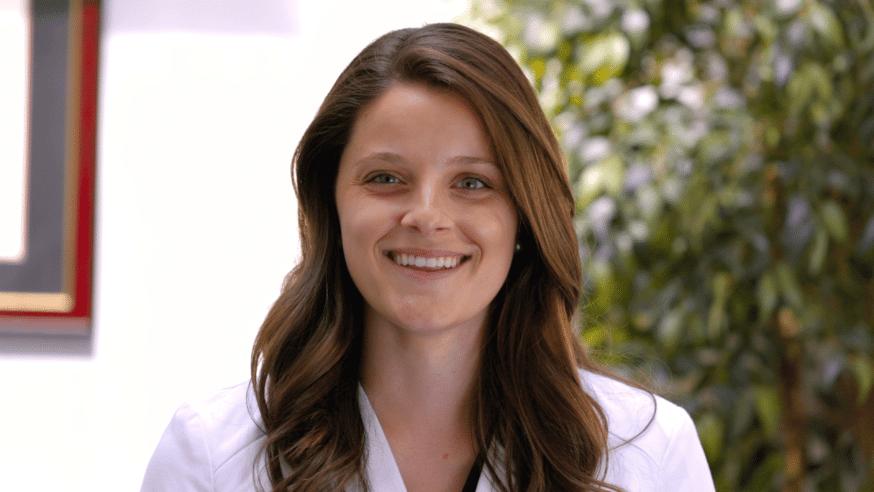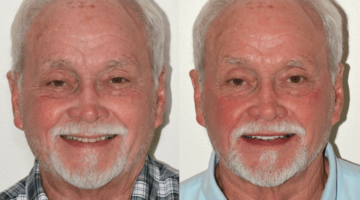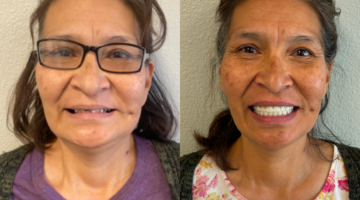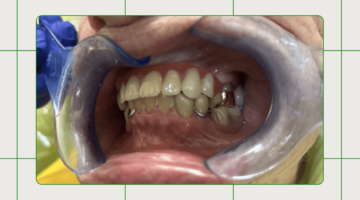Meet Dr. Ashley Ciapciak
Dr. Ashley Ciapciak is no stranger to digital dentistry. She explains, “I was trained by Boston University School of Dental Medicine, where they often make a really big push for us to learn digital scanning and digital techniques.”
Because she was trained in CEREC, that might have seemed like the best option for going digital. But there were two problems. First, not all the dental labs in her area accepted CEREC scans. On top of that, Dr. Ciapciak found the CEREC machine difficult to use when scanning for dentures.
She was stuck.
“I considered sending scans overseas to get my dental work done, to get my crowns finished,” she admits. To compound the problem, COVID-19 would make training difficult, especially for a senior dentist in her practice who was hesitant to switch to a digital scanner.
“He thought that it was going to be poor margins.” Dr. Ciapciak says. “He thought that it was going to be grainy. He didn’t think that he could get a really good scan.”
Undeterred, Dr. Ciapciak did extensive research and recognized that Dandy was the solution she’d been looking for.
It all started with the scanner.
Dandy has allowed us to cut down on chair time probably about 15 to 20%. Now I can see four more patients in my day than I was able to before.
Dr. AshLEY Ciapciak
The Dandy Difference
Dr. Ciapciak is a perfectionist when it comes to dental work for her patients. “I am a Type A person, I want perfect dental work for my patients. And part of that is we need really, really, really clear dental impressions.”
“The Dandy scanner is incredible,” she says. “It’s one of the best scanners on the market. That was really important to me. I wanted really good detail.”
Training and Support
Dr. Ciapciak assumed it would be up to her to train her staff on the digital scanner. She was pleasantly surprised to learn that a Dandy professional instructor would train her, her colleagues, and the staff.
“I was really relieved that I didn’t have to take on that responsibility,” she says.
Still, her team was dreading training, anxious about having to learn something new. What if it was hard to learn? What if they couldn’t get it right? The anxiety was unnerving. And since the COVID-19 pandemic was ongoing, the Dandy training would be virtual instead of in-person. How on earth would they learn to use a digital scanner via a computer screen?
All those fears were put to rest when training started.
If I had known that the transition was going to be this easy, and that teaching my staff how to digitally scan was going to be this simple, I would have switched to Dandy years ago.
“Our trainer was patient with my team,” recalls Dr. Ciapciak. “They were kind. They talked us through absolutely every step. And they were available for the next few weeks in case we had problems, questions, or concerns as we were scanning.”
The Dandy trainer spent a morning with Dr. Ciapciak’s practice – about four hours – teaching everyone how to use the digital scanner virtually. By the end of the training, everyone was buzzing with excitement.
In fact, the most senior dentist in the practice – the one initially most hesitant – was the most adept at using the scanner. Why?
Dr. Ciapciak thinks his years of dental experience made the transition effortless.
“He knows what he’s doing around a patient’s mouth,” she explains. “So, it wasn’t a difficult transition for him to hold a different instrument in his hand and run it along the teeth and get a good impression.”
The Results
Dr. Ciapcak decided to run a test.
She continued to take traditional impressions along with digital scans. If she didn’t like the work coming back from the digital scan, she planned to use the physical impression instead.
What were the results?
1. Consistent, High-Quality Restorations
“The reality was I loved the work that was coming back. And I’ve had no complaints and no problems fitting crowns for my patients. Really, all of the work that’s coming back from our labs has been beautiful. I haven’t had anything returned to them.”
But that’s not the only result.
2. Reduced Chair Time = More Patients in the Chair
How long does it typically take a dentist to capture a physical impression? How does that compare to doing a digital scan?
“I can scan in about a minute, rather than waiting 5, 10 minutes for my impressions to set,” says Dr. Ciapciak. Redos aren’t a problem either. “If I have to redo an impression with my digital scanner, I just cut out that little piece that I don’t like as much and I rescan and it takes 10 seconds maybe.”
All of that saved time adds up to more appointments in the day.
3. Faster Lab Turnaround Times
Going digital with Dandy made a significant difference in turnaround times.
“It’s incredible to see how quickly I can turn around a case for a partial denture or a complete denture through our scanners with Dandy,” says Dr. Ciapciak.
Before Dandy, dental assistants had to wait for Dr. Ciapciak to formally write a full traditional lab prescription. Then, they would box up the prescription along with traditional models that they had to pour up, and ship the package out to the dental lab. Now it just takes three clicks of a button for a case to be sent out.“Using a traditional dental lab for partial dentures takes six to eight weeks. Using Dandy … takes a week, maybe two, to turn around that partial denture and get it back in the patient’s mouth and get them back to smiling.”
Smiling patients are the best benefit of all.
4. Happier Patients
“Our patients are much happier to receive digital scans rather than traditional impressions,” says. Dr. Ciapciak. “I have a significant number of patients with a gag reflex. And then we have to hold them down for two to five minutes with traditional impressions. It’s just too long.”
“They were very uncomfortable.”
Dr. Ciapciak is also seeing greater patient buy-in to recommended treatment plans, thanks to Dandy digital scans. It helps when patients have a visual image of what’s going on in their mouth.
“Now they see it on the big screen and they’re saying, ‘Oh my gosh, doc, you’re right. Now I see what you’re talking about.’”
Adopting New Workflows
Switching to Dandy meant a change in some of Dr. Ciapciak’s workflows. But the benefits are clear.
Switching from Invisalign to Dandy Clear Aligners
Even though Dr. Ciapciak is Invisalign-certified, she prefers the Dandy clear aligner program.
“I’ve really found Invisalign to be a little bit frustrating,” she explains. “It’s more expensive for my patients, it takes longer for us to get a treatment plan, and it’s just become a frustrating process.
“When I switched to Dandy, I loved their clear aligners. It’s just super easy for myself and my patients to receive their cases and to receive their clear aligners in a really timely manner.”
With Dandy, the entire process is easier, quicker, more affordable for the patient, and far more straightforward.
Digital Dentures
Using a traditional dental lab for partial dentures would take six to eight weeks. And that meant a lot of gooey impressions and several follow-up visits for patients who were often older, with limited mobility; those repeat visits were challenging. But with Dandy, a partial denture is done in 1-2 weeks and most full dentures are completed in only 2 appointments.
“My patients are much happier that their dental work comes back way, way quicker than it ever has before,” says Dr. Ciapciak.
Dr. Ciapciak’s only regret is that she didn’t find Dandy sooner. For those dentists on the fence, she recommends taking the leap of faith.
“If you’re hesitant about switching to Dandy, you really shouldn’t be,” she counsels. “They hold your hand throughout the whole process.”
“If I had known that the transition was going to be this easy, and that teaching my staff how to digitally scan was going to be this simple, I would have switched to Dandy years ago.”



